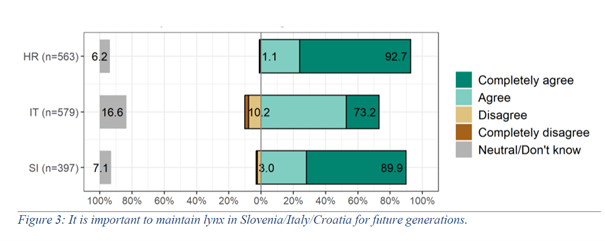Understanding public perceptions helps wildlife management authorities and conservationists gauge the level of acceptance or opposition to the presence of lynx in specific regions. Within the LIFE Lynx project, we had the unique opportunity to study the attitudes of different stakeholder groups (general public, hunters, and livestock breeders) before, during, and after translocation of 18 animals from Romania and Slovakia to Slovenia and Croatia.
Public support in Slovenia, Croatia and Italy for lynx conservation remained strong throughout the project. Support for population reinforcement translocations was high and even increased during the mid-project period. As project outcomes were more extensively communicated towards the project’s conclusion, there was a slight decline in support among Italian respondents, although the majority still supported the translocation efforts aimed at rescuing the lynx population. Within the three stakeholder groups, livestock breeders showed the lowest support for lynx, however the majority of livestock breeders still expressed support for lynx conservation in all 3 countries.

Public attitudes survey in 2023 – about importance to maintain lynx for future generations, showed great support for the lynx to maintain in Slovenia, Italy and Croatia.
Looking ahead, public outreach activities in the following years should address the importance of lynx conservation in the long term, which means connection of Dinaric-SE Alpine lynx population with the neighboring populations or (if needed) additional lynx translocations in the future to prevent inbreeding. Ultimately the long-term conservation of lynx in Slovenia, Croatia, and Italy is dependent on fostering and maintaining local support. As human-wildlife interactions and environmental conditions evolve, so do people’s attitudes. Consistent monitoring ensures that wildlife management approaches remain responsive to societal perspectives and fosters a more sustainable coexistence between large carnivores like lynx and local communities.
More information on the survey can be found in the Final report (English, pdf).
